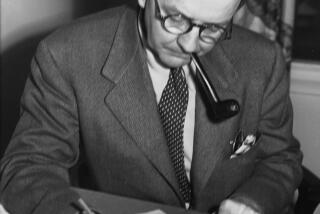‘Torment Saint’ illuminates the troubled world of Elliott Smith
Ten years ago this November singer-songwriter Elliott Smith, then 34, died in an Echo Park bungalow from two knife stabs to the chest. According to William Todd Schultz’s “Torment Saint: The Life of Elliott Smith,” a clear-eyed and devastating new biography of the gifted and troubled artist, his death, likely a suicide, was inevitable. The only questions were how and when.
Smith is most widely known for the use of his somber, melodic music to soundtrack Gus Van Sant’s “Good Will Hunting” and a white-suited performance during the 1998 Academy Awards of the song “Miss Misery.” Since his death, his legacy, already sprouting while he was alive, has grown.
FOR THE RECORD:
Elliott Smith: A review of the book “Torment Saint: The Life of Elliott Smith” in the Arts & Books section elsewhere in this edition says that singer-songwriter Smith died 10 years ago this November. He died Oct. 21, 2003. The error was detected after the section went to press. —
The Smith in “Torment Saint” embodies an archetype: depressed artist filled with demons and dedicated to documenting and (hopefully) exorcising them through music. As the singer, thoughtful and well spoken, explained of his craft, “You gotta get out there and show what it’s like to be a person, that’s what I’m gonna do. It might be good or it might be bad, but I’m gonna show what it’s like to be a person.”
Books: Sign up for our email newsletter
He did so through a series of intimate, half-whispered records that rejoiced in grand melodies simply presented. Starting with 1994’s lo-fidelity masterpiece “Roman Candle” and continuing through his final studio album, “Figure 8” (2000), Smith gracefully ascended to become a grand composer, signed to a fledgling DreamWorks Records, an artist able to take over Capitol Studios for days on end.
Illuminating his world through insightful interviews, Schultz strings together recollections from classmates in the Dallas suburbs where Smith grew up, college friends during time spent in Amherst, Mass., band mates from his years in Portland, Ore., with the ‘90s post-grunge band Heatmiser, girlfriends and business associates. Through it all Smith’s life seems to teeter on a precipice.
His promise was obvious, as were his troubles, so much so that friends devoted hours to nursing Smith as he wallowed in depression. Schultz describes this period of drunkenness and impending addiction as embodying “the archetypal forked road. One route led to redemption, the other contamination” — someone who “much of the time and against his own interests, chose the darker side streets.”
Schultz devotes much space to the music, chronicling tracks and references through the voices of those nearest to him (many of whom became subjects of songs). The writer has obviously internalized Smith’s work and honors its spirit through precise, descriptive notes and observations.
But Smith’s life constantly drags the story back from the sublime as Schultz describes a man immersed in drug addiction. At his lowest point, reports Schultz, he carried his pills onstage in a toiletry bag, his habit costing him an estimated $1,500 a day.
The author, a psychology professor at Pacific University in Oregon who has also written books on Diane Arbus and Truman Capote, devotes equal passion to reporting the facts and deflating the myths of his subject’s life. Schultz at times leans toward armchair analysis, but in a way that can be revelatory.
After a stint couch-surfing in New York, Smith landed in Los Angeles in the late 1990s, where he lost control. He got hooked on smoking heroin and crack and partaking in a cocktail of pain pills and Adderall while studying pharmacological texts.
The final chapters are hard to bear as Smith slurs his way through concerts, quitting songs midway through and obsessing over a studio soundboard while maintaining a death wish. At one point, writes Schultz, Smith told girlfriend Jennifer Chiba that “it might not be a very good idea to get close, because he wasn’t planning on being around much longer.”
Schultz with unblinking eye describes a man unstable and paranoid — convinced, for example, that DreamWorks Records had bugged his house and was following him in white vans — lost to psychosis and desperately trying to hold on.
Because of extenuating factors Smith’s death wasn’t ruled a suicide but “undetermined,” a detail that has led to various misguided conspiracy theories as to Chiba’s role. How could a person stab himself not once but twice with a newly sharpened kitchen knife? Were two small wounds on his hand and arm defensive? Why didn’t he take off his shirt before pushing the knife through his rib cage?
Well aware of this, Schultz solidly examines each angle, speaking with the forensic pathologist/deputy medical examiner who filed his death certificate, interviewing Chiba and others. He lays out his case with great care, well aware that Smith’s fans, obsessed as some of them are, will pore over his text.
But the author of this portrait, one as heartbreaking and well-crafted as one of Elliott Smith’s songs, need not have worried about a bow-tied ending. In “Torment Saint,” Schultz has made clear with precise writing and even pacing the many ways in which Smith’s fate had long ago been sealed.
Torment Saint
The Life of Elliott Smith
William Todd Schultz
Bloomsbury: 368 pp., $27
More to Read
Sign up for our Book Club newsletter
Get the latest news, events and more from the Los Angeles Times Book Club, and help us get L.A. reading and talking.
You may occasionally receive promotional content from the Los Angeles Times.






